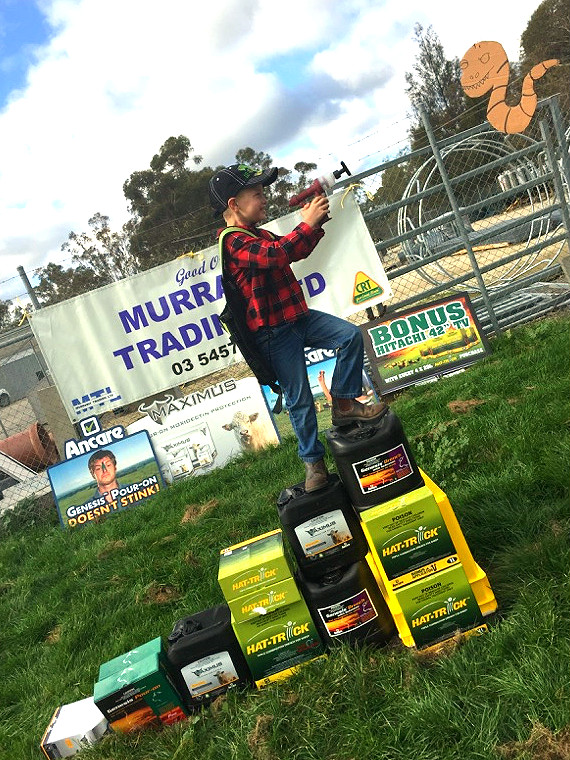Murrabit Trading keeps an excellent range of animal health products from Boehringer Ingelhein, Virbac, Elanco , Zoetis and more. Cattle, sheep, goats, pigs, dogs, cats, poultry & horses are all covered either by product in store or our ability to source products promptly. Cattle pour-on, oral or injectable treatments for internal and external parasites. Oral drenches and vaccines for sheep or lice treatments in backliner or dipping products. Frontline Plus for dogs and cats, Drontal wormers or Advocate to cover the lot. Olsson Lick Blocks in a variety of combinations are always available. There is of course calf, pig, horse, dog, cat and poultry feeds in store at all times. If you have an interest in lot feeding sheep or cattle, or just want some general advice, then try the links below
Feedlotting-lambs 7 in 1 Vaccine
Beef cattle feedlotting Tech Update – Pulpy Kidney – SheepGoats
Sheep Lice Control Glanvac-6_DM-vaccinating sheep grazing on stubble
Grass Tetany
Hypomagnesaemic tetany – Grass Tetany
What causes Hypomagnesaemic Tetany?
– Hypomagnesaemic tetany occurs in calves, lactating cows, bullocks, lacatating ewes and sheep grazing winter forage. The extent of losses attributed to grass tetany have been estimated at as high as 1% of Victorian beef cattle. With grazing animals, the problem may be due to low magnesium in the grazing pasture, but it is more commonly associated with low availability of magnesium from pastures that contain dietary acceptable levels. The fact that magnesium levels in pasture were adequate led to the conclusion that the disease was metabolic in origin. The condition can also be caused by temporary starvation following good feeding, a picture similar to that seen in pregnancy toxaemia. Although it can occur at any time in dairy cattle following lactation (commonly within the first 2 months in cattle), grass tetany is more commonly associated with rapidly growing pasture. As a result, the incidence tends to be seasonal and related to rainfall. While higher stocking rates as a result of the feed available may be responsible, the problem is more usually related to fertilizer treatment that seems to render the magnesium unavailable to the animal or reduce the amount present in the plant. Phosphate and nitrogen fertilization increases magnesium uptake by herbage while potassium decreases the amount absorbed by the animal.
The manner in which magnesium in the rumen is rendered unavailable to the animal is still unknown. The problem may be related to herbage species and certainly trials on
grasses such as white clover and rye grass suggest that availability of magnesium may not be a simple intra-rumenal phenomenon.
Treatment – The onset of tetany is generally sudden and often severe. The disease is essentially a mineral deficiency but it can be controlled by ensuring adequate intake of forage. Attempts to move the animals to a site for treatment can lead to collapse and death. Interest is now centred on prevention rather than cure with supplementation of magnesium, trace minerals and molasses. Supplementation can be easily supplied with the daily protein concentrate to dairy cows, but with grazing livestock, licks or molasses mixtures should be used. Due to the variability of intake and forage quality involved of grazing pastures, the supplementation of magnesium in these cases is more complicated and a magnesium supplement should be available ad lib before and during traditional Grass Tetany seasons.
In point form, the main factors leading to the onset of Grass Tetany are:
- Reduction in feed intake usually related to new growth of short green grass.
- Little roughage available.
- High potassium and low sodium intakes.
- Low magnesium and low calcium intakes.
- High rumen ammonia concentration.
- Over fat at calving, rapid weight loss at calving.
- Foggy, cloudy, cold or windy weather.
- Susceptible breeds and older cows.
- Stress. E.g. yarding, chasing, presence of dogs.
- Phosphorus deficiency (especially in young cows).
- Improved pastures
Measures to reduce the incidence of grass tetany include:
- Feeding hay.
- Supplementing with magnesium, trace minerals and molasses.
- Reduce incidence of cows being fat at calving.
- Paddock shelter: Choose a paddock with trees, valleys, etc.
- Reduce stress: Do not yard or chase cattle.
- Change breeding season.
Olsson’s Grass Tetany Beefmaster is a molasses/mineral supplement block high in magnesium and containing phosphorus, calcium and other trace minerals, and designed to correct nutritional imbalances before the onset of Grass Tetany. The high molasses content makes the block very palatable, and thus easy to administer, as stock consume the block whenever they need to. Its durability and weather-resistance make it a very economical and labour-efficient way to protect your cattle. Beefmaster’s unique blend of minerals is also of great benefit to the welfare of lactating cows, and the bone and tissue development of calves. For further information about Beefmaster, Grass Tetany or magnesium supplementation, please call the Olsson’s Nutritional Advisory Service on FreeCall: 1800 804 096 (Contact: Dr. W. Backhouse). Beefmaster is available in 15kg and 40kg blocks.


